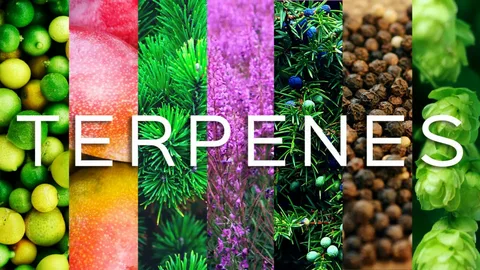Cannabis has long been associated with THC and CBD, the most well-known compounds driving its effects. But another set of naturally occurring compounds—terpenes—are proving to be equally influential in shaping how cannabis affects both the mind and body. Found not just in cannabis but in countless plants, terpenes are aromatic oils responsible for the unique scents of different strains, from citrusy and fruity to earthy or pine-like. More importantly, terpenes interact with cannabinoids and the body’s endocannabinoid system to influence how a strain makes you feel.
We will explore how terpenes impact the cannabis experience in surprising and meaningful ways beyond aroma or flavor. Their presence isn’t merely sensory—it’s physiological, therapeutic, and deeply tied to your overall experience with each product you choose. Whether you’re a first-time consumer or someone seeking more refined effects, terpenes offer a powerful key to understanding cannabis on a deeper level. At Green Cannabis Co. Dispensary Hualapai, recognizing the role of terpenes helps guide customers toward strains and products that align with their specific goals and preferences.
How Terpenes Influence Your High, Mood, and Wellness
1. Terpenes and the Entourage Effect
The term “entourage effect” describes how various cannabis compounds work synergistically to enhance the overall experience. Terpenes play a major role in this process. While THC and CBD are central to cannabis’ psychoactive and physical effects, they don’t act in isolation. When combined with terpenes, cannabinoids can produce more nuanced responses. For example, linalool—a terpene also found in lavender—has calming properties. When paired with THC, linalool may amplify relaxation or promote sleep.
On the other hand, limonene, a citrus-scented terpene, may uplift mood or counterbalance the sedative effects of certain cannabinoids. The entourage effect challenges the idea that higher THC automatically means a more powerful or enjoyable experience. Instead, it suggests that strain composition—including terpene content—determines the overall impact. This is why two strains with identical THC levels can produce very different results. Paying attention to terpenes helps consumers better predict how a product will make them feel, which can lead to more intentional and satisfying use.
2. Common Cannabis Terpenes and Their Roles
Cannabis strains contain a unique blend of terpenes, contributing to their distinct aromas and effects. Myrcene, for example, is one of the most prevalent terpenes and is often found in mangoes, hops, and lemongrass. It’s known for its musky, herbal aroma and is typically associated with relaxation and sedative properties. Myrcene-rich strains are often chosen by those seeking physical calm or sleep support. Pinene, as its name implies, smells like pine and is also found in conifer trees. This terpene is known for its potential to improve alertness and memory retention.
Limonene, with its bright citrus scent, is associated with elevated mood and reduced stress. Then there’s caryophyllene, which smells peppery and is unique among terpenes because it interacts directly with cannabinoid receptors, particularly CB2 receptors linked to inflammation and pain. Understanding these terpenes gives consumers a practical way to guide their choices, aligning specific aroma profiles with their wellness or recreational goals.
3. Aroma as a Guide, Not Just a Scent
When browsing cannabis flower or concentrates, many consumers are drawn to smell first. While the scent can be attractive, it’s also a powerful clue to how the strain might affect you. Since terpenes are responsible for those aromas, paying close attention to the scent can give you insight into the expected experience. A strain that smells sweet and citrusy might be high in limonene, hinting at mood-lifting qualities. An earthy or musky scent may indicate a high myrcene content, suggesting calming or body-relaxing effects. Because everyone’s body chemistry differs, aroma offers a more personalized selection method than lab numbers alone.
Depending on their biology or mental state, some individuals may respond more positively to strains rich in one terpene over another. By using your nose and learning to associate specific scents with your body’s responses, you can become more intuitive in finding cannabis products that genuinely suit your needs and preferences.
4. Terpenes in Vapes, Edibles, and Topicals
Although terpenes are most noticeable in dried flower, they are also preserved or added in many other cannabis formats, including vapes, edibles, tinctures, and topicals. Manufacturers may reintroduce botanical or cannabis-derived terpenes in vape cartridges to maintain flavor and effect profiles. These terpenes can shape not only the taste but also the experience itself. For example, a vape pen designed for focus may feature pinene or limonene to sharpen the mind. While cooking and manufacturing can degrade some terpenes in edibles, careful formulation ensures that many products retain their desired effects.
Topicals—creams, balms, and oils—may use terpenes like linalool or caryophyllene for their potential anti-inflammatory or soothing properties. Consumers can check product labels or ask dispensary staff to better understand terpene inclusion. As more products emphasize terpene content, it’s becoming easier to choose cannabis formats that align with specific effects—whether you’re vaping discreetly, consuming edibles for long-lasting relief, or using topicals for targeted support.
Understanding terpenes reshapes how we engage with cannabis. Rather than focusing only on THC or strain names, we can use scent, effect profiles, and product labels to make better-informed decisions based on individual preferences and needs. Terpenes aren’t just about smell—they influence mood, physical sensation, and how the body responds to cannabinoids. From pinene’s alertness-boosting potential to the calming nature of linalool, each terpene brings something unique to the table.
As cannabis becomes more refined and consumers become more intentional, paying attention to terpene profiles becomes an essential part of the experience. Whether you’re seeking creativity, calm, energy, or comfort, terpenes offer a reliable guide in the journey toward a more satisfying and purposeful cannabis experience.
